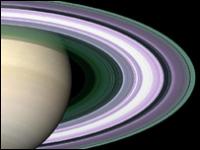







|
News and Information
Cassini makes detailed ring map
| May 24, 2005 |

By Dr David Whitehouse
Science editor, BBC News website
A simulated colour image maps the differences in particle size and density
Enlarge Image
The Cassini probe has obtained the most detailed view yet of Saturn's ring system, making clear even a ring that had eluded previous space missions.
By passing radio waves through the rings, the spacecraft was able to measure the size of the ice and rock fragments from which they are made.
The denser the material in the rings, the weaker the radio signal received from Cassini back on Earth.
The joint US-European mission has been in orbit around Saturn since last July.
Ring tone
This was Cassini's first so-called radio occultation observation of Saturn's rings, atmosphere and ionosphere - meaning that Cassini made the study as it passed behind the rings as seen from Earth. It took place on 3 May.
The observation involved the transmission through the rings of three radio signals of different frequencies. The signals were picked up on Earth by the US space agency's (Nasa) Deep Space Network.
SATURN'S RINGS
Not solid but rather a collection of countless particles
Composition of particles is predominantly water-ice
Sizes range from near-invisible dust to large 'icebergs'
Ring system is made up of thousands of ringlets
Spacing and widths influenced by orbiting moons
Rings may be shattered debris of old moons
Ring particles of assorted sizes were seen to affect each tone in a different way.
The Cassini mission was designed to optimise the geometry of the first radio occultation experiment and seven further occultations scheduled from May to September 2005. During its lifetime, Cassini will obtain a total of 20 radio occultations of the rings.
Saturn's rings are enormous structures. From edge to edge, they would not even fit in the distance between Earth and the Moon. The seven main rings are labelled in the order they were discovered. From the planet outward, they are D, C, B, A, F, G and E.
"All ring features appear to be populated by a broad range of particle sizes that extend to many metres in diameter at the upper end," said Dr Essam Marouf, Cassini radio science team member.
Marouf said, at the lower end, particles of about 5cm in diameter or less seemed to be scarce in ring B and inner ring A. However, in ring C and outer ring A, particles of less than about 5cm in diameter seem to be abundant.
'Marvellous array'
During the radio observation, Cassini discovered that the inner and outer parts of ring B contain internal rings that are hundreds of kilometres wide and vary greatly in the amount of material they contain.
A thick, 5,000km-wide core of ring B contains several bands with ring material nearly four times as dense as that of ring A, and nearly 20 times as dense as that of ring C.
The dramatically varying structure of ring B is in sharp contrast to the relatively flat structure of ring A or the gentle, wavy structure of ring C, where many dense, narrow and sharp-edged ringlets permeate its outer part.
Cassini also detected more than 40 rippled features called "density waves" in ring A, many near its outer region, close to the moons that orbit just outside the ring.
"A marvellous array of waves, caused by gravitational interactions with nearby moons, has been uncovered throughout ring A," said Marouf.
"We also see a major density wave in the dense ring B. Some of these waves have been seen in Voyager and other Cassini observations, but not in this large number and not with this exceptional clarity." |
Source: www.bbc.com |
| http://news.bbc.co.uk/2/hi/science/nature/4574239.stm |
|
| Support Caprivi Freedom |
Fill out the form below to become a member of this site and receive our regular newsletter.
|

|

